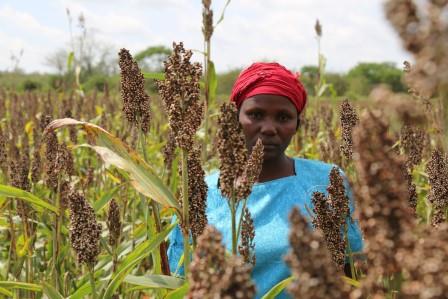Kitui sorghum farmers have decried lack of market despite bumper harvest and called for government intervention to set market prices to improve the orphaned crops sector.
Speaking to KNA in Nuu on Thursday, Mwema Musembi, a retired chief in the area said that a group of over 60 sorghum farmers were worried following the bumper harvest amid fears of exploitation from middlemen.
“The rain season has really favoured this region. I planted sorghum on my 28 acre-piece of land. Due to the prolonged rainfall which affected some of the crop, I expect to harvest over 300 bags from my initial estimate of 380 bags,” said Musembi.
The former chief disclosed that sugarcane, dairy and rice farmers have received government support during the recent past with pronouncements on how much they should sell their produce but nothing was forthcoming in favour of farmers of traditional crops.
“We appeal to the government to include farmers growing traditional orphaned crops such as sorghum and millet into their programmes. As farmers, we want to increase our sorghum grain market margin by engaging in collective market action to compete with brokers and rural assemblers,” he said.

Musembi said that drought resistant crops such as sorghum growing is aimed at reducing rural poverty, improve food security and nutrition.
“We are also contributing to the president’s Big 4 Agenda of enabling poor rural women and men to have access to and take advantage of improved agricultural technologies and effective production services of orphaned crops,” he added.
Musembi challenged the county government’s agricultural extension officers to train farmers on on-farm seed production and preservation to improve the quality of recycled seed in a bid to maximize their yields.
Commenting on why he abandoned maize farming, another farmer, Michael Muthoka said the returns from sorghum farming were high and the crop husbandry challenges such disease infestation was minimal.
“One acre of maize yields around four to five bags in a single season. The farm inputs are expensive too. Whereas one acre of sorghum yields over ten bags and the farm inputs are relatively lower compared to other crops,” said Muthoka.
He said that projections of total harvest in his 27 acre farms is close to 300-400 bags of sorghum, adding, “I call upon the government to assist us get market for our produce since East African Breweries may not buy all our sorghum this season.’
Timothy Maundu, a youth in Nuu, challenged his peers to venture into farming rather than depending on government employment or parents for upkeep.
“I ventured into sorghum farming to start eking a living since there is ready market for the produce and the cost of production is manageable,” said Maundu.
Muise Muli said that the area’s sorghum farmers are expecting a bumper harvest and asked agents to East Africa Breweries Limited (EABL) to give them fair prices in a bid to improve their livelihoods owing to the rising cost of living and production.
Kenya Agricultural and Livestock Research Organization (KALRO) scientist Rose Nelima explained that the institution has developed five new improved varieties that can withstand harsh climatic conditions, are fast maturing that can be used for both human and animals and whose level of cyanide is low.
“These varieties are good. We also know that our animals are in the ASAL areas, thus most of these varieties have also been recommended for dry areas to help in terms of food security and at the same time our animals can get feed,” added Nelima.
One Kilo of sorghum seeds goes for Sh350 and a farmer will require to use 3 to 4 kgs for an acre,” she said.
According to Tegemeo Institute, in 2018 there was increased research in the development of new varieties of sorghum but the adoption is low due to lack of awareness and access-related constraints.
In Kenya, sorghum is grown in western, northern Rift Valley, Eastern and some parts of Central. The research objectives in sorghum research are increased yield, drought, disease and pest tolerance, earliness, seed colour and marketability.
A research by EABL in 2017 revealed that Kenya trails her neighbours in sorghum production due to use of uncertified seeds by farmers.
According to the research, Kenya produced 144, 000 metric tonnes of sorghum and imported 133,000 metric tonnes to curb the deficit while Ethiopia leads the region with over 280, 000 tonnes, Uganda approximately 170, 000 tonnes while Tanzania produced 155, 000 tonnes.
By Yobesh Onwong’a





